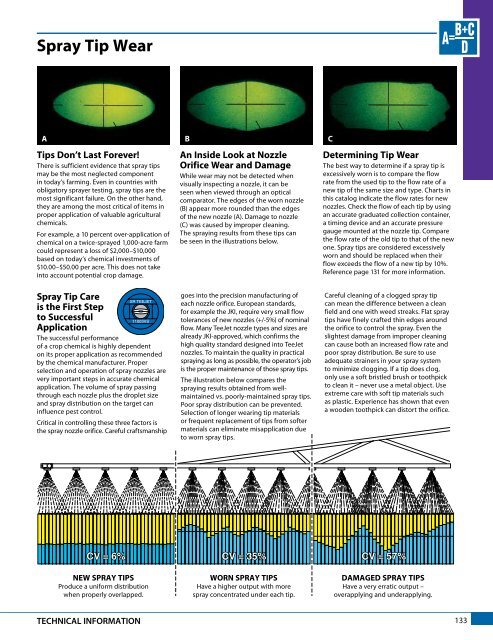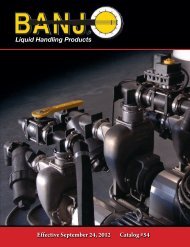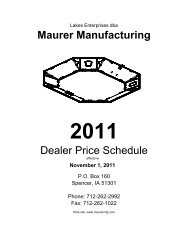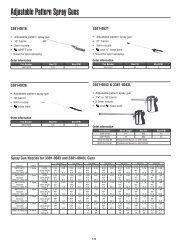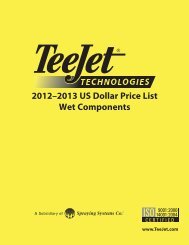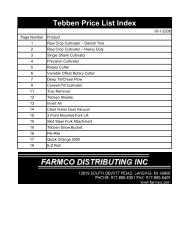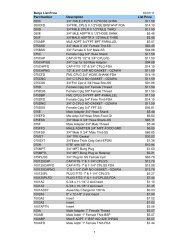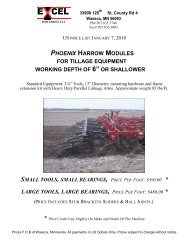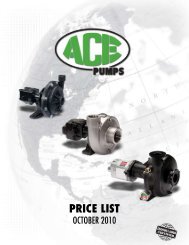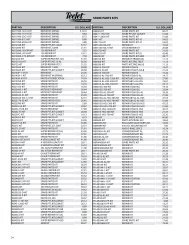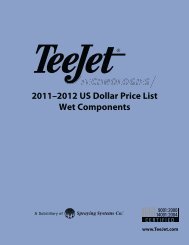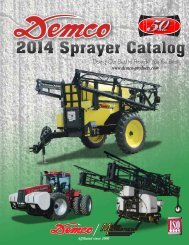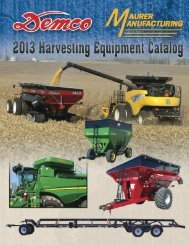Teejet Catalog 51 - Farmco Distributing Inc
Teejet Catalog 51 - Farmco Distributing Inc
Teejet Catalog 51 - Farmco Distributing Inc
Create successful ePaper yourself
Turn your PDF publications into a flip-book with our unique Google optimized e-Paper software.
Spray Tip Wear<br />
A<br />
Tips Don’t Last Forever!<br />
There is sufficient evidence that spray tips<br />
may be the most neglected component<br />
in today’s farming. Even in countries with<br />
obligatory sprayer testing, spray tips are the<br />
most significant failure. On the other hand,<br />
they are among the most critical of items in<br />
proper application of valuable agricultural<br />
chemicals.<br />
For example, a 10 percent over-application of<br />
chemical on a twice-sprayed 1,000-acre farm<br />
could represent a loss of $2,000–$10,000<br />
based on today’s chemical invest ments of<br />
$10.00–$50.00 per acre. This does not take<br />
into account potential crop damage.<br />
Spray Tip Care<br />
is the First Step<br />
to Successful<br />
Application<br />
The successful performance<br />
of a crop chemical is highly dependent<br />
on its proper application as recommended<br />
by the chemical manufacturer. Proper<br />
selection and operation of spray nozzles are<br />
very important steps in accurate chem ical<br />
application. The volume of spray passing<br />
through each nozzle plus the droplet size<br />
and spray distribution on the target can<br />
influence pest control.<br />
Critical in controlling these three factors is<br />
the spray nozzle orifice. Careful craftsmanship<br />
B<br />
An Inside Look at Nozzle<br />
Orifice Wear and Damage<br />
While wear may not be detected when<br />
visually inspecting a nozzle, it can be<br />
seen when viewed through an optical<br />
comparator. The edges of the worn nozzle<br />
(B) appear more rounded than the edges<br />
of the new nozzle (A). Damage to nozzle<br />
(C) was caused by improper cleaning.<br />
The spraying results from these tips can<br />
be seen in the illustrations below.<br />
goes into the precision manufacturing of<br />
each nozzle orifice. European standards,<br />
for example the JKI, require very small flow<br />
tolerances of new nozzles (+/-5%) of nominal<br />
flow. Many TeeJet nozzle types and sizes are<br />
already JKI-approved, which confirms the<br />
high quality standard designed into TeeJet<br />
nozzles. To maintain the quality in practical<br />
spraying as long as possible, the operator’s job<br />
is the proper maintenance of those spray tips.<br />
The illustration below compares the<br />
spraying results obtained from wellmaintained<br />
vs. poorly-maintained spray tips.<br />
Poor spray distribution can be prevented.<br />
Selection of longer wearing tip materials<br />
or frequent replacement of tips from softer<br />
materials can eliminate misapplication due<br />
to worn spray tips.<br />
C<br />
Determining Tip Wear<br />
The best way to determine if a spray tip is<br />
excessively worn is to compare the flow<br />
rate from the used tip to the flow rate of a<br />
new tip of the same size and type. Charts in<br />
this catalog indicate the flow rates for new<br />
nozzles. Check the flow of each tip by using<br />
an accurate graduated collection container,<br />
a timing device and an accurate pressure<br />
gauge mounted at the nozzle tip. Compare<br />
the flow rate of the old tip to that of the new<br />
one. Spray tips are considered excessively<br />
worn and should be replaced when their<br />
flow exceeds the flow of a new tip by 10%.<br />
Reference page 131 for more information.<br />
Careful cleaning of a clogged spray tip<br />
can mean the difference between a clean<br />
field and one with weed streaks. Flat spray<br />
tips have finely crafted thin edges around<br />
the orifice to control the spray. Even the<br />
slightest damage from improper cleaning<br />
can cause both an increased flow rate and<br />
poor spray distribution. Be sure to use<br />
adequate strainers in your spray system<br />
to minimize clogging. If a tip does clog,<br />
only use a soft bristled brush or toothpick<br />
to clean it – never use a metal object. Use<br />
extreme care with soft tip materials such<br />
as plastic. Experience has shown that even<br />
a wooden toothpick can distort the orifice.<br />
NEW SPRAY TIPS<br />
Produce a uniform distribution<br />
when properly overlapped.<br />
WORN SPRAY TIPS<br />
Have a higher output with more<br />
spray concentrated under each tip.<br />
DAMAGED SPRAY TIPS<br />
Have a very erratic output –<br />
overapplying and underapplying.<br />
TECHNICAL INFORMATION<br />
133


